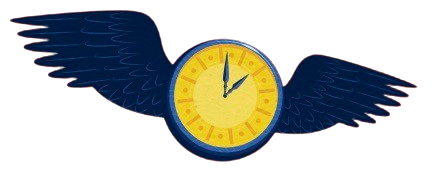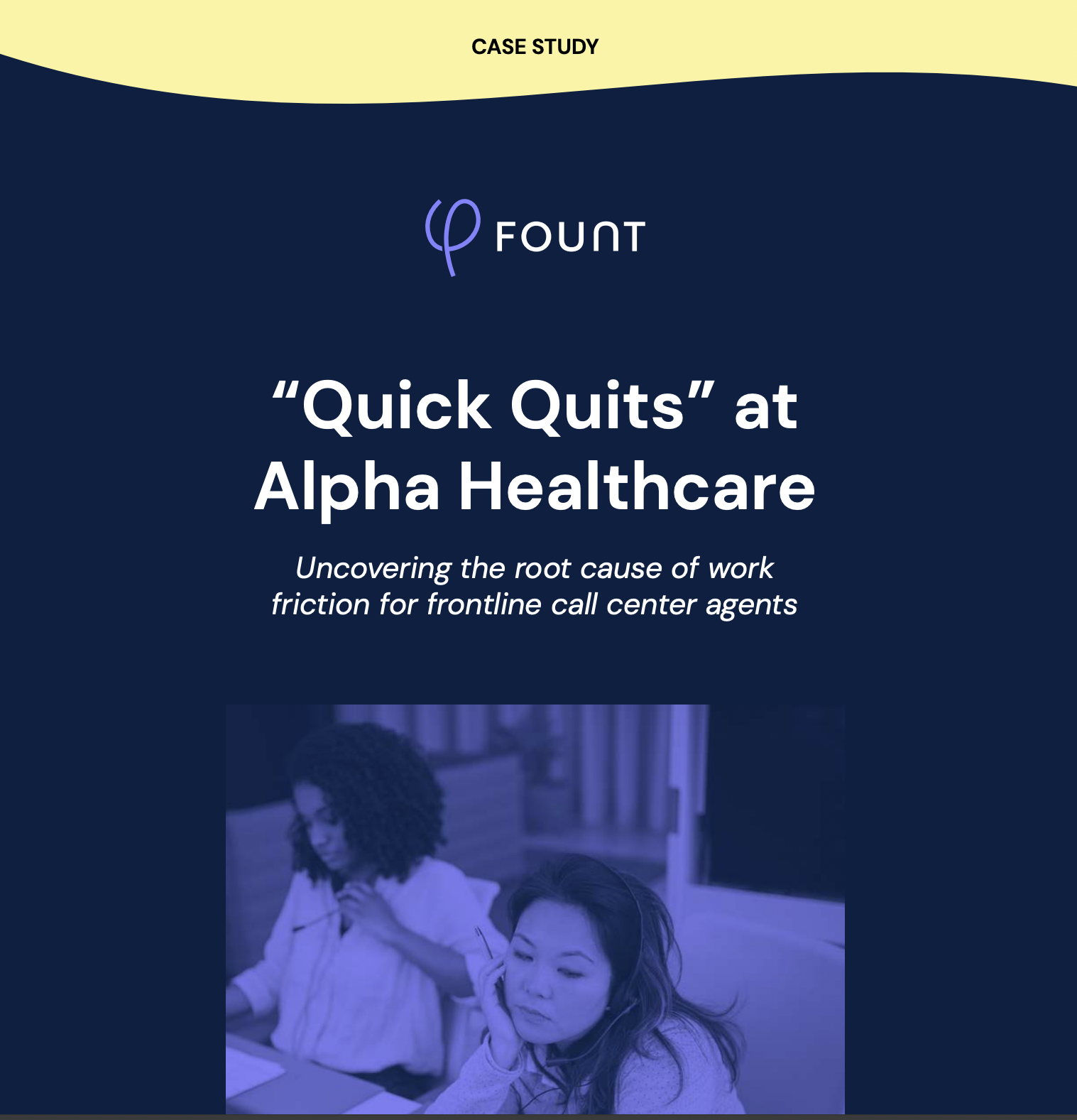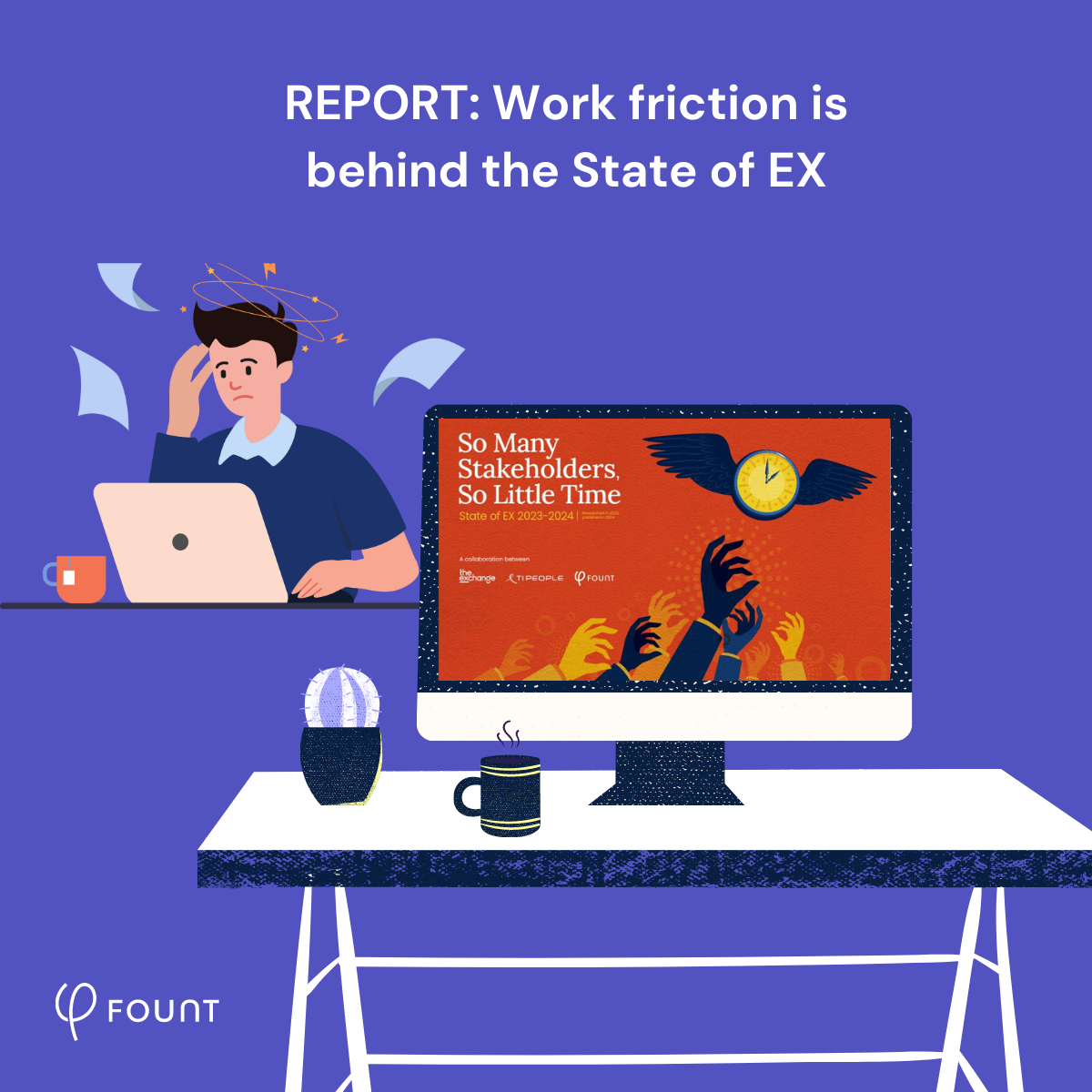Christophe Martel met with George LaRocque at WorkTech to discusses FOUNT’s recent funding and how its friction management solution can help companies make their work environments easier for employees to work in.
George LaRocque is founder and principal analyst of WorkTech, an advisory firm focused on HR, HR technology, and the trends shaping them. In this interview, FOUNT Cofounder and CEO, Christophe Martel, discusses the pervasiveness of work friction and how FOUNT’s recent funding will be directed toward efforts to help organizations reduce the invisible headwinds their employees face in their day-to-day jobs. Listen or read the full transcript below.
TRANSCRIPT:
GL: Welcome back to work Tech it’s George LaRocque and we’ve got some industry funding news to discuss today. FOUNT announced a round of growth funding of eight million dollars. FOUNT is an employee experience solution and Christoph Martel the CEO and founder of FOUNT is here to talk about the deal and tell us more about FOUNT. Welcome Christophe.
CM: Thank you, thanks for having me. Good morning.
GL: It’s great to meet you. I spend a lot of time in the employee experience space so I’m as excited as the audience to learn more about FOUNT and about your deal. But let’s start out with a quick introduction – if you could just tell us a little bit about yourself and the quick “what is FOUNT” story.
CM: Let’s see, my background is mostly a business leadership background. I worked for about 15 years at a company called CEB – Corporate Executive Board – acquired by Gartner in 2017. I spent most of those years as a business leader heading the EMEA region … London and then transferred to HR to become CHRO in the last few years before the acquisition.
I’m not really qualified as a proper HR person… spent in enough years in it to be a little bit dangerous but that’s it. One thing that it did highlight for me was that employee experience – which everyone knows is incredibly important for the health of a business – is as much an HR problem as it is a business problem given that these two functions essentially share the load of experiences that are provided to employees. And in my time as a business leader I expected HR to sort it out… in my time as an HR leader I expected the business to sort it out. And the truth is really in the middle. That’s kind of what what prompted the creation of this business which is to help large companies understand the friction that their workers… employees experience on a day-to-day basis whether it’s with their work – so whatever their work might be – their day-to-day activity or what I would call “life at work things” like career planning and using benefits and so on and so forth.
So the question is how do you break down the big massive experiences that people have every day to understand which ones are working and which ones are not working so that we can go fix it? I found myself just unable to do that in my time at CEB and that’s why this company was created.
GL: Great. So, I noticed in looking at your site and your messaging the word friction is used a lot. It talks about identifying those points and improving them and where you ended is sort of where I’d like – it’s a great segue. How do you identify those points of friction and how far do you go in solving them – or how do you help solve them?
CM: One thing that I observed just transitioning from the business to HR is how little success metrics you have in HR. It’s very difficult to know if you’re solving the right problems and whether or not you’re solving them because you know the only metrics that are typically used are employee engagement metrics that are more about how people feel which is not hard enough to see if you’re really making a difference.
At FOUNT, we’ve focused most of our fire on creating data that is going to pinpoint where the friction occurs in a way that aligns everyone within an organization. So, between the business and HR and IT and everyone involved in all these experiences to say here’s what is causing friction, here’s how it breaks down and here’s how we can solve it cross-functionally. Data is at the center of our business because it allows not only to understand what’s happening but also to measure the progress that’s being made. We do this with a data model that’s pretty unique – that is centered on the goals that people have and the activities that they undertake when pursuing these goals.
For example, pursuing a new role… that’s an example of something that individuals try to do. Well, what happens when they try to pursue a new role? What gets in their way of solving a customer problem if they’re a customer facing a team member? The heart of our product is actually about collecting data that represents the friction that these people experience across these multiple activities and the multiple things they interact with and things and people and processes and so on so forth. And that helps the organization actually improve its own environment to make it easier for people to work there. That’s something that is easy to do in a smaller company but much harder to do the bigger you get. The less visibility you have into what parts of the company’s ecosystem are working for people and not working…
GL: Yeah, is that done passively? Is the system – you know – observing the tasks or listening or is it a survey?
CM: On our forward roadmap there is a bunch of passive data intake to provide context however there’s kind of a central assumption in our work is that employees don’t like surveys when surveys are not acted upon, right? So, just like the same thing as the customers – if I don’t think you’re going to do anything with my feedback I would rather just not give you any. And the same thing is a little bit at play right now in organizations. But we actually believe that employees want agency. So, in other words, if you ask them for feedback in order to improve their work environment and to make it easier for them to do their job and to perform, you’re going to find that all of them will lean in actually and not only in providing data but also in helping create solutions for the problems that they encounter every day.
So instead of trying to “sneak on” employees and then rain down solutions on them, we believe that it’s better to actually involve them in both the sourcing of the problems that they encounter and the resolution of them. We use a survey approach and actually we can run on a variety of server platforms but it’s what I would call a very economic survey solution in that you essentially don’t need to survey a lot of people to get great insights about what’s happening for employees at work. So it’s a very high-efficiency survey solution. We’re actually not shameful about asking employees for input but we do it in the most economical way possible and our customers are usually focused on following up on this feedback by taking action and then closing the loop afterwards to make sure that improvements are real and can even be reported internally.
GL: As far as differentiation it sounds like your data model is one of the unique things about FOUNT? How does that data model present itself as differentiation for the employees or the customer?
CM: Typical feedback platforms actually try to understand how people feel about the company and I’ve used these platforms. At CEB, we even had our own brew of it and it’s very effective to understand who in a team is getting disengaged or having feelings that are categorized in certain drivers of their overall engagement and that’s actually really useful for business managers – people that have teams in the front lines and want to know how their teams are doing that’s great however when you’re in the business of trying trying to make the environment work for employees so if you’re in the HR team or the IT team or if you’re a very senior business leader where essentially workflows are created for the workers in the front line. There’s a dearth of data that tells you what gets in the way of people what causes friction for them when they try to do stuff and you know our data model actually portrays this friction in the context of the activities that these people are trying to perform and that makes it uniquely effective at designating the things or processes or policies or whatever in the environment that are really getting in the way. And it’s usually relatively easy to fix – not everything needs to be a transformational design approach. So that companies kind can essentially start having impact on this environment even if it’s through quick wins but then over time just go after more ambitious things.
GL: Okay, interesting. That all tracks to my experiences as well so I really appreciate that approach especially earlier I’m not a big fan of the listening approach. I’ve got an eight-year-old and she’s been learning the difference between listening and eavesdropping and I think a lot of the tech solutions could could use some of her experiences lately but that being said I’d like to move on to the deal and and keep the conversation going.
So, eight million dollars of growth capital – congratulations – this is not an environment where it’s as easy as it once was. I don’t think it was ever easy but it’s definitely not as easy as it was to raise capital so that’s a that’s a feat in and of itself. Great validation. I’m curious what was happening in the market or at FOUNT or both that led you to this time for that Capital raise.
CM: So what’s happening in the market is that there’s a little bit of a – you know – post-COVID hangover happening in the world of HR right where COVID was really a license for HR teams to ask for anything from the leadership team to say, “hey all workers are remote, we need to show some love right now.” And that did happen across the two years of COVID. Towards the end of last year what we did see is that companies started tightening the belt a little bit on employee investments and it’s still continuing today. That drove the the trend that you described also for HR technology companies as a result.
What made us special actually is that friction is not just an employee problem. Friction is actually a productivity problem when you really think about an employee doing their work the the time that they spend doing – what I would call useless stuff for lack of a better word – is essentially wasted work. So if you’re the CFO of a company and someone tells you that there’s up to 15 or 20 percent of the activities that workers do that is actually wasted… that feels like a good thing to go after.
This notion of friction is unique in that it is both an enemy of the CFO and CEOs of these companies but also an enemy of the workers so when you do work and you feel the company is putting obstacles in your way when you’re just trying to do your work. There’s nothing more frustrating than that and more disengaging than that. If you think about things like burnout and under-performance and quiet quitting and all these phenomena – many of them are actually caused by just an overload of controls and things and rules that people that probably makes sense from the center’s perspective right from the head of corporate finance and whoever manages operations. But when you’re a worker and looking at this gigantic machinery that you have to carry, it becomes a lot more frustrating. So the business case for our solution is usually a dual business case 1) increasing people’s performance and productivity and 2) make sure that their work is less frustrating than it currently is. And that’s what I think – that was a story that resonates with both companies today and also investors.
GL: Ok, so now you’ve got this eight million – or however it is being delivered, how do you plan to use it? What’s the plan for the funds?
CM: Well, Plan A was to make sure it was not in one of those banks that got in trouble so that was a little bit scary. So Plan A was to not lose it…
GL: … that’s a good starting point…
CM: Plan B was to actually build a product. So, our our product is very powerful right now and you know one of the things that created the investment opportunity for investors was we have a lot of big companies that are struggling to resolve this friction problem and this is just a unique way of doing it. Our growth last year was such that we’re on the beginning of a pretty exciting run. What’s going to take us to the next level is to actually build up our product – both the types of data we can ingest and convert to our data model, but also the support that the solution can provide beyond providing insights but also helping these organizations solve these problems by co-creating with employees which is a really important aspect of our methodology. So there’s a lot of product to create, there’s a lot of software to build and that’s expensive as you know. So that is where most of our focus is at the moment.
GL: Okay, so what kind of impact will this all have? I always think of the three constituencies – the customers, the employees and then the market at large, what can customers expect now that you’re off and running on this?
CM: I think we’re only at the beginning of our story, right? We’ve uncovered this big giant headwind that this kind of resisting both employees and companies trying to do things better and our product is miles ahead of anything else out there to again to problem solve that thing. There is so much we can build and some of the areas that we’re building our product into are actually specific Talent segments. So think about call center agents, right? These are rules with really high attrition particularly in the United States and when you actually look at how much friction call center agents have to deal with on a day-to-day basis not surprising that there is a lot of attrition.
Same thing for nurses, right? So these are especially after COVID very highly pressured talent segments where there’s enormous attrition. Many many open jobs right now in the United States are nurse jobs and again friction is one of the biggest causes of turnover there. Think about engineers. Software engineers or retail workers so these specific talent segments where we actually have mapped their day-to-day work activities to understand what gets in the way of them doing you know ambition being their best basically right so that’s a big area of investment from a product perspective and then the second one is essentially a more comprehensive solution to enable people to not only understand where the problems are, co-create solutions for them, but also close the loop all that in an environment that recognizes people that do the work, that shows best practices and so on so forth. So there’s a lot of great things that we have in mind in the future
GL: That’s great and I’m curious on the employee front, are you growing or is there a lot of movement internally right now?
CM: No, we’re just building up our product and engineering team mostly. You know we’re we’re pretty disciplined about where we invest these funds. We will invest more heavily in sales and all these things once we feel we’re uh you know we’ve got a team where we need to be in terms of product and engineering and we’re almost there to be honest but there’s still some work to do so we’re recruiting pretty heavily right now.
GL: Okay, well this is a good place to get that word out so that’s good if you want.
CM: If you want to build friction-fighting code, please reach out.
GL: All right, I think we’ve talked a lot about the market and how you’re different and what the market can expect. And you’ve touched on the roadmap. Where should folks go in order to learn more about the product and the company?
CM: Yeah, our website is fount-ex.com. That’s the best of the best place to go. Just as a note, we’re rebuilding our entire marketing engine so our website is pending revision, but what’s there is already helpful and… or, contact me directly if need be.
GL: Well I have to say this sounds really interesting. I have talked a lot about and explored employee experience a lot over the years. This is the first friction conversation around productivity that I’ve had so I find it very interesting. Congrats again on the deal and thank you so much for telling your story here at Work Tech.
CM: Thank you, George. I appreciate the opportunity and as you said, employee experience is so large a topic that is often easy to get lost in it, and I think that we’ve provided a unique shortcut to essentially having an impact on it which is you know dearly needed in this environment. Thanks for the opportunity to speak.
GL: My pleasure and thanks to everyone who’s watching or listening. Until next time…












